The Veterinary Thermography Market is estimated to be valued at USD 215.0 billion in 2025 and is projected to reach USD 455.6 billion by 2035, registering a compound annual growth rate (CAGR) of 7.8% over the forecast period.
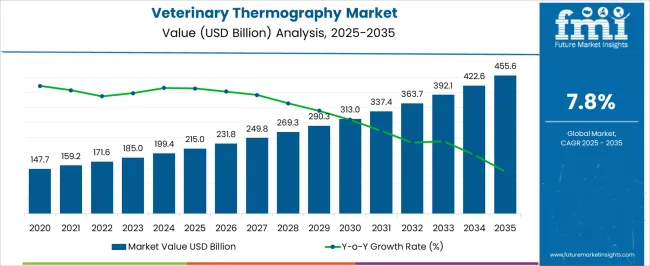
| Metric | Value |
|---|---|
| Veterinary Thermography Market Estimated Value in (2025 E) | USD 215.0 billion |
| Veterinary Thermography Market Forecast Value in (2035 F) | USD 455.6 billion |
| Forecast CAGR (2025 to 2035) | 7.8% |
The Veterinary Thermography market is experiencing robust growth, driven by the increasing adoption of non-invasive diagnostic tools in veterinary healthcare. Rising awareness of animal health monitoring, early disease detection, and preventive care is fueling the demand for thermography solutions. The market is further supported by advancements in infrared imaging technologies, higher-resolution sensors, and improved data processing capabilities, which enhance diagnostic accuracy and efficiency.
Growing adoption of long-wavelength thermography cameras enables veterinarians to capture precise thermal patterns, supporting timely interventions and reducing the risk of chronic conditions. Integration with software analytics and mobile platforms allows for real-time monitoring and remote consultation, improving accessibility and treatment outcomes. As animal healthcare providers, research institutions, and clinics prioritize accuracy, efficiency, and safety, thermography solutions are becoming a preferred choice.
The combination of non-invasive imaging, operational efficiency, and enhanced clinical decision-making is driving market expansion Investments in veterinary infrastructure and the increasing prevalence of companion animals globally are expected to sustain long-term growth.
The veterinary thermography market is segmented by product type, application, end user, and geographic regions. By product type, veterinary thermography market is divided into Long-Wavelength Thermography Cameras, Short-Wavelength Thermography Cameras, and Mid-Wavelength Thermography Cameras. In terms of application, veterinary thermography market is classified into Veterinary Diagnosis, Inflammation, Muscle Injury, Nerve Injury, Pain Management, Preventive Medicine, Physiologic Monitoring And Animal Welfare Assessment, and Others. Based on end user, veterinary thermography market is segmented into Veterinary Clinics, Veterinary Diagnostic Center, and Research Institutes. Regionally, the veterinary thermography industry is classified into North America, Latin America, Western Europe, Eastern Europe, Balkan & Baltic Countries, Russia & Belarus, Central Asia, East Asia, South Asia & Pacific, and the Middle East & Africa.
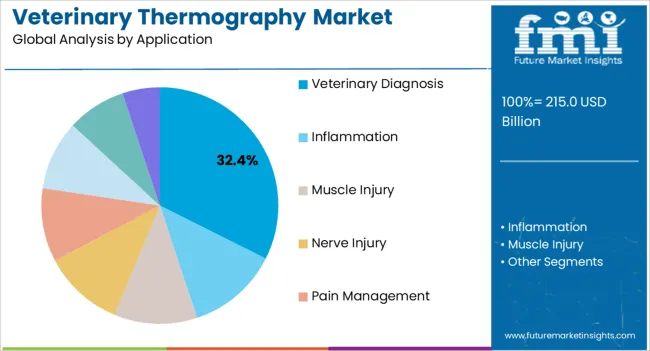
The long-wavelength thermography cameras segment is projected to hold 41.2% of the market revenue in 2025, establishing it as the leading product type. Its dominance is being driven by superior imaging capabilities that allow precise detection of subtle temperature variations, which are critical for early diagnosis of animal health issues. The ability to capture thermal patterns without physical contact ensures safety and reduces stress for animals during examinations.
Integration with analytical software enables veterinarians to detect inflammation, musculoskeletal injuries, and circulatory abnormalities with higher accuracy. Advancements in sensor technology and calibration techniques have improved reliability and consistency, reinforcing preference among veterinary professionals.
The cameras’ adaptability across multiple animal species, clinical settings, and research applications further strengthens their market leadership As demand for non-invasive diagnostic methods rises and veterinary clinics adopt advanced imaging solutions, long-wavelength thermography cameras are expected to maintain their leading position, driven by technological innovation and clinical efficacy.
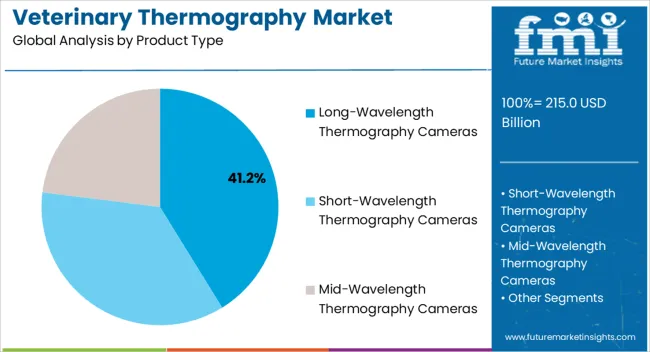
The veterinary diagnosis application segment is anticipated to account for 32.4% of the market revenue in 2025, making it the leading application area. Its growth is fueled by the increasing need for accurate, non-invasive diagnostic methods in animal healthcare. Veterinary thermography enables detection of musculoskeletal injuries, inflammatory conditions, and circulatory disorders without causing discomfort or stress to animals.
High-resolution thermal imaging, combined with analytical software, provides veterinarians with actionable insights that improve treatment planning, early intervention, and recovery monitoring. The ability to integrate thermography data into electronic health records enhances clinical workflows and supports longitudinal studies. Rising adoption in research, rehabilitation, and preventive care further reinforces its market share.
The segment benefits from growing awareness among veterinarians, pet owners, and livestock managers regarding the advantages of non-invasive imaging As veterinary healthcare continues to emphasize precision, efficiency, and animal welfare, the veterinary diagnosis segment is expected to remain the primary growth driver in the market.
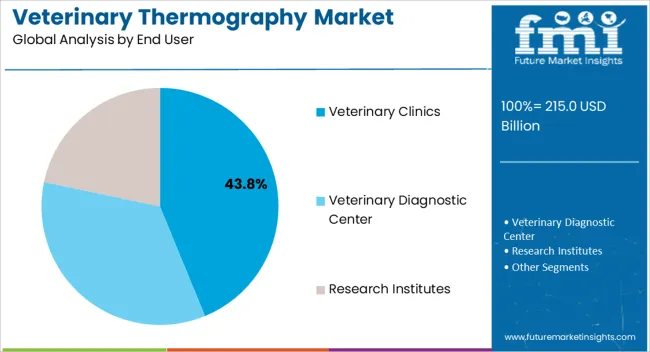
The veterinary clinics segment is projected to hold 43.8% of the market revenue in 2025, establishing it as the leading end-use category. Growth in this segment is being driven by the rising number of veterinary facilities and the increasing integration of advanced diagnostic equipment to enhance service quality. Clinics are leveraging thermography solutions for early detection, preventive care, and ongoing monitoring of animal health, improving clinical outcomes and client satisfaction.
The non-invasive nature of thermography allows for safer and faster assessments, which is particularly valuable in busy clinical settings. Adoption is further supported by ease of use, portability, and compatibility with analytical software that enables detailed reporting and longitudinal tracking of animal health conditions.
The segment benefits from growing awareness among pet owners and livestock managers regarding the importance of timely diagnosis and treatment As veterinary clinics continue to invest in modern diagnostic technologies and prioritize efficiency and accuracy, the segment is expected to sustain its leading market position, reinforcing the overall growth of the veterinary thermography market.
Veterinary Thermography is a remote, non-contact and non-invasive method for veterinary monitoring based on physiological imaging as a function of metabolic actions in the animal body. Infrared thermography or thermal imaging use thermographic cameras which can detect radiations in the long infrared range of electromagnetic spectrum and produce images called thermograms.
Thermograms i.e. physiological images depict temperature of an object with different color for different temperature and can be used for veterinary diagnosis. The use of thermography for monitoring of animal health is rapidly growing area due to rapid developments in the veterinary science. Veterinary thermography is increasingly gaining popularity as an equine and canine diagnostic solution as abnormal body temperature is considered as a major indicator of disease.
Thermography technique is crucial in helping diagnose inflammation or lack of blood circulation to a particular area in the animal body. Veterinary thermography can be used to detect the location of dysfunction in its early stages without sedation and touching the animal and animals are also avoided from unnecessary discomfort.
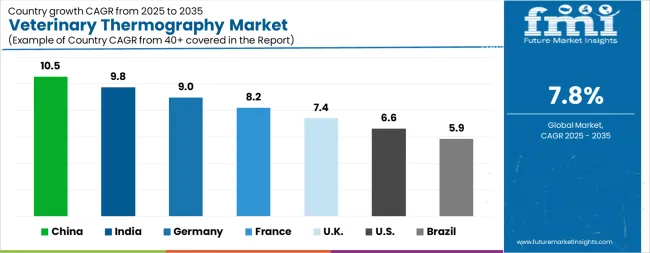
| Country | CAGR |
|---|---|
| China | 10.5% |
| India | 9.8% |
| Germany | 9.0% |
| France | 8.2% |
| UK | 7.4% |
| USA | 6.6% |
| Brazil | 5.9% |
The Veterinary Thermography Market is expected to register a CAGR of 7.8% during the forecast period, exhibiting varied country level momentum. China leads with the highest CAGR of 10.5%, followed by India at 9.8%. Developed markets such as Germany, France, and the UK continue to expand steadily, while the USA is likely to grow at consistent rates. Brazil posts the lowest CAGR at 5.9%, yet still underscores a broadly positive trajectory for the global Veterinary Thermography Market. In 2024, Germany held a dominant revenue in the Western Europe market and is expected to grow with a CAGR of 9.0%. The USA Veterinary Thermography Market is estimated to be valued at USD 79.2 billion in 2025 and is anticipated to reach a valuation of USD 150.6 billion by 2035. Sales are projected to rise at a CAGR of 6.6% over the forecast period between 2025 and 2035. While Japan and South Korea markets are estimated to be valued at USD 9.9 billion and USD 5.4 billion respectively in 2025.
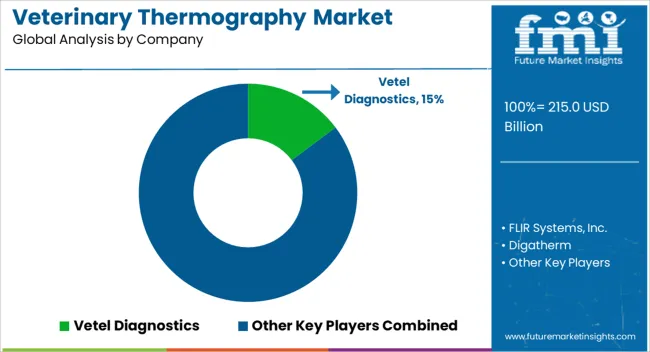
| Item | Value |
|---|---|
| Quantitative Units | USD 215.0 Billion |
| Product Type | Long-Wavelength Thermography Cameras, Short-Wavelength Thermography Cameras, and Mid-Wavelength Thermography Cameras |
| Application | Veterinary Diagnosis, Inflammation, Muscle Injury, Nerve Injury, Pain Management, Preventive Medicine, Physiologic Monitoring And Animal Welfare Assessment, and Others |
| End User | Veterinary Clinics, Veterinary Diagnostic Center, and Research Institutes |
| Regions Covered | North America, Europe, Asia-Pacific, Latin America, Middle East & Africa |
| Country Covered | United States, Canada, Germany, France, United Kingdom, China, Japan, India, Brazil, South Africa |
| Key Companies Profiled | Vetel Diagnostics, FLIR Systems, Inc., Digatherm, Meditherm, Animal Infrared Imaging, Veterinary Thermal Imaging Ltd., Thermology Diagnostics, Teletherm Infrared Systems, Vet-Therm, Infrared Cameras Inc., Thermal Imaging Services Ltd., Vet Therm, and Thermo Diagnostic Imaging |
The global veterinary thermography market is estimated to be valued at USD 215.0 billion in 2025.
The market size for the veterinary thermography market is projected to reach USD 455.6 billion by 2035.
The veterinary thermography market is expected to grow at a 7.8% CAGR between 2025 and 2035.
The key product types in veterinary thermography market are long-wavelength thermography cameras, short-wavelength thermography cameras and mid-wavelength thermography cameras.
In terms of application, veterinary diagnosis segment to command 32.4% share in the veterinary thermography market in 2025.






Our Research Products

The "Full Research Suite" delivers actionable market intel, deep dives on markets or technologies, so clients act faster, cut risk, and unlock growth.

The Leaderboard benchmarks and ranks top vendors, classifying them as Established Leaders, Leading Challengers, or Disruptors & Challengers.

Locates where complements amplify value and substitutes erode it, forecasting net impact by horizon

We deliver granular, decision-grade intel: market sizing, 5-year forecasts, pricing, adoption, usage, revenue, and operational KPIs—plus competitor tracking, regulation, and value chains—across 60 countries broadly.

Spot the shifts before they hit your P&L. We track inflection points, adoption curves, pricing moves, and ecosystem plays to show where demand is heading, why it is changing, and what to do next across high-growth markets and disruptive tech

Real-time reads of user behavior. We track shifting priorities, perceptions of today’s and next-gen services, and provider experience, then pace how fast tech moves from trial to adoption, blending buyer, consumer, and channel inputs with social signals (#WhySwitch, #UX).

Partner with our analyst team to build a custom report designed around your business priorities. From analysing market trends to assessing competitors or crafting bespoke datasets, we tailor insights to your needs.
Supplier Intelligence
Discovery & Profiling
Capacity & Footprint
Performance & Risk
Compliance & Governance
Commercial Readiness
Who Supplies Whom
Scorecards & Shortlists
Playbooks & Docs
Category Intelligence
Definition & Scope
Demand & Use Cases
Cost Drivers
Market Structure
Supply Chain Map
Trade & Policy
Operating Norms
Deliverables
Buyer Intelligence
Account Basics
Spend & Scope
Procurement Model
Vendor Requirements
Terms & Policies
Entry Strategy
Pain Points & Triggers
Outputs
Pricing Analysis
Benchmarks
Trends
Should-Cost
Indexation
Landed Cost
Commercial Terms
Deliverables
Brand Analysis
Positioning & Value Prop
Share & Presence
Customer Evidence
Go-to-Market
Digital & Reputation
Compliance & Trust
KPIs & Gaps
Outputs
Full Research Suite comprises of:
Market outlook & trends analysis
Interviews & case studies
Strategic recommendations
Vendor profiles & capabilities analysis
5-year forecasts
8 regions and 60+ country-level data splits
Market segment data splits
12 months of continuous data updates
DELIVERED AS:
PDF EXCEL ONLINE
Veterinary Point of Care Diagnostics Market Size and Share Forecast Outlook 2025 to 2035
Veterinary Allergy Diagnostics Market Size and Share Forecast Outlook 2025 to 2035
Veterinary TSE Testing Market Size and Share Forecast Outlook 2025 to 2035
Veterinary Dermatology Market Forecast Outlook 2025 to 2035
Veterinary Telemedicine Market Size and Share Forecast Outlook 2025 to 2035
Veterinary Dietary Supplements Market Size and Share Forecast Outlook 2025 to 2035
Veterinary Imaging Market Forecast and Outlook 2025 to 2035
Veterinary CRISPR-Based Detection Kits Market Size and Share Forecast Outlook 2025 to 2035
Veterinary Pregnancy Test Kit Market Forecast and Outlook 2025 to 2035
Veterinary X-Ray Illuminators Market Size and Share Forecast Outlook 2025 to 2035
Veterinary Scales Market Size and Share Forecast Outlook 2025 to 2035
Veterinary Grooming Aids Market Size and Share Forecast Outlook 2025 to 2035
Veterinary Micro-fibre Endoscope Market Size and Share Forecast Outlook 2025 to 2035
Veterinary Faecal Filters Market Size and Share Forecast Outlook 2025 to 2035
Veterinary Dental Equipment Market Size and Share Forecast Outlook 2025 to 2035
Veterinary Rapid Test Market Size and Share Forecast Outlook 2025 to 2035
Veterinary Therapeutic Diet Market Size and Share Forecast Outlook 2025 to 2035
Veterinary Glucometers Market Size and Share Forecast Outlook 2025 to 2035
Veterinary Pain Management Drugs Market Size and Share Forecast Outlook 2025 to 2035
Veterinary Anesthesia Machines Market Size and Share Forecast Outlook 2025 to 2035

Thank you!
You will receive an email from our Business Development Manager. Please be sure to check your SPAM/JUNK folder too.
Chat With
MaRIA